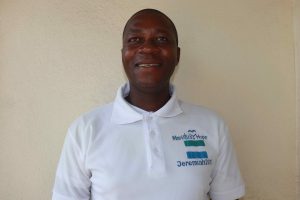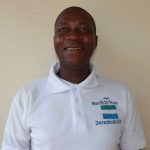Every year from February to May, Amaraya's well dries from seasonality and overuse. During this time, the 156 community members are left scooping up containers of water from the local swamp. This negatively impacts everyone in the community, but especially those who use water for their livelihoods, like 41-year-old palm oil producer Kadiatu Kamara.
"The water situation is affecting me as a trader," said Kadiatu (shown in the photo below carrying water). "I process and sell palm oil to make a living, and processing palm oil requires a lot of water. It is a hard task, but if water is available, the work will be done faster. The problem I face now is the main water source is presently dry, which is a seasonal pattern. Every dry season, the water source dries out."

"This increases the burden for me because I must fetch water for our use at home and then fetch extra water to process the palm kernels into palm oil," Kadiatu continued. "Imagine having the responsibility of cooking every day for an extended family. Water is needed to do many domestic tasks, but due to the walking distance and frequent overcrowding at [our] alternate water source, activities at home [are] greatly affected."
The community's well was built in 1987, so it's no wonder that fluctuations in the region's water table have caused the well to run dry. The only wonder is that Amaraya's people have been able to keep up with everyday tasks for as long as they have using unsafe water from an open source—and the local swamp, too, has begun to turn to mud in the long periods between bursts of rainfall due to overuse. This leaves community members worried about what they will do if both of their available water sources dry up entirely.
"The water situation is delaying the work I normally do at home," said 13-year-old Mariama (shown below collecting water from the swamp).

"I am the eldest child in my family and my siblings are under the age of seven. I have no one to help me to fetch water for my parents. When the well had water, I was able to fetch water without walking a far distance because the well is close to our house. Since it dried out, I find it very difficult to fetch water from the swamp. The swamp source is far from our [house] and most times, [it] is crowded with people also fetching water, especially in the morning hours," Mariama said.

"The delay in fetching water from the swamp slows the work I must do every day, such as washing dishes, cleaning the bath shelter, and fetching drinking water," Mariama continued. "On Saturdays, the competition at the swamp water source is high. I normally use that opportunity to [do laundry] at the swamp. As time goes on, the water in the swamp changes color. This makes it difficult for me to fetch drinking water when returning home. There are times the water at the swamp will be less due to [the] large number of water users at this water point."
Unfortunately, the swamp water is undeniably dangerous for human consumption. Community members like Mariama use the banks of the swamp to do domestic activities like laundering clothes, bathing, and farming. The water is cloudy in color, and the majority of those who drink it complain of stomach pain, diarrhea, and typhoid. The swamp is also a frequent drinking point for animals.
A rehabilitated well will allow Amaraya's people to drink safe water from a reliable source, freeing up time and rejuvenating their health.
The Proposed Solution, Determined Together...
At The Water Project, everyone has a part in conversations and solutions. We operate in transparency, believing it benefits everyone. We expect reliability from one another as well as our water solutions. Everyone involved makes this possible through hard work and dedication.
In a joint discovery process, community members determine their most advantageous water solution alongside our technical experts. Read more specifics about this solution on the What We're Building tab of this project page. Then, community members lend their support by collecting needed construction materials (sometimes for months ahead of time!), providing labor alongside our artisans, sheltering and feeding the builders, and supplying additional resources.
Water Access for Everyone
This water project is one piece in a large puzzle. In Kenya, Sierra Leone, and Uganda, we’re working toward complete coverage of reliable, maintained water sources that guarantee public access now and in the future within a 30-minute round trip for each community, household, school, and health center. One day, we hope to report that this has been achieved!
Training on Health, Hygiene & More
With the community’s input, we've identified topics where training will increase positive health outcomes at personal, household, and community levels. We’ll coordinate with them to find the best training date. Some examples of what we train communities on are:
- Improved hygiene, health, and sanitation habits
- Safe water handling, storage & treatment
- Disease prevention and proper handwashing
- Income-generation
- Community leadership, governance, & election of a water committee
- Operation and maintenance of the water point





 Borehole Well and Hand Pump
Borehole Well and Hand Pump




























